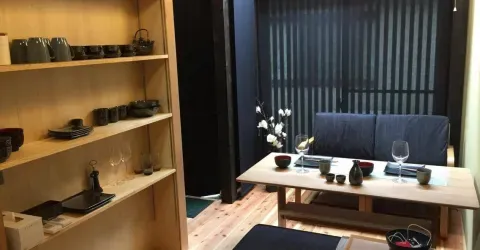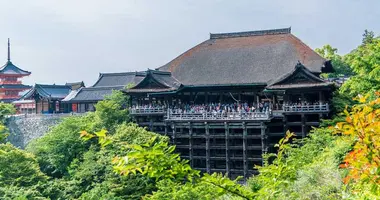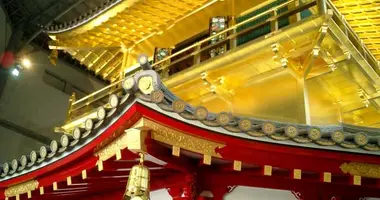Discovering the authentic rural charm of Miyama, Japan's thatched roof farmhouse village
Exploring Kayabuki no Sato, Miyama's main thatched roof village
The main attraction in Miyama is Miyama Town's northern village of Kayabuki no Sato, home to nearly 40 thatched roof farmhouses, the highest concentration in Japan. Strolling through the quiet hamlet, you'll spot local craftspeople at work, from carpenters to thatchers and basket makers. While most houses are private residences, the Kayabuki no Sato Folk Museum allows visitors to see inside a traditional farmhouse, with exhibits on local farming tools and thatched roof construction. The nearby Little Indigo Museum showcases the indigo dyeing craft of artist Hiroyuki Shindo.
As you wander the village lanes, small atmospheric shrines appear, like the 600-year-old Suwa Shrine with its ancient trees. The rural landscape is especially picturesque in winter under a blanket of snow, and during the annual Snow Lantern Festival in late January when the village is illuminated with glowing snow lanterns at night. Imagine the magic of kayabuki farmhouses with snow-laden thatched roofs glowing in the festive lights!

Visiting Miyama's museums to learn about its traditional culture and crafts
To dive deeper into Miyama's traditional way of life, head to the town center where Highway 162 meets Highway 12. Here you'll find two small museums: the Kayabuki Art Museum with changing exhibits of local traditional crafts like pottery, painting and woodcarving, and the Miyama Regional Museum displaying folk crafts and tools of the region. A combination ticket grants access to both for 500 yen.
For a hands-on experience, participate in a traditional craft workshop. At the Little Indigo Museum, you can try your hand at indigo dyeing, while local shops offer bamboo weaving, pottery and woodworking classes. Making your own one-of-a-kind souvenir is a memorable way to connect with Miyama's living crafts heritage. After admiring kayabuki thatching, why not join a mini-workshop to learn the basics of this impressive architectural skill?
Enjoying outdoor activities like sweetfish fishing and hiking along the Yura River
With its pristine natural setting, Miyama is a paradise for outdoor enthusiasts. The Yura River that winds through the valleys is renowned for ayu or sweetfish, a local delicacy. From July to August, you can try your hand at traditional fishing, scooping up the prized fish with nets or fishing rods. Then grill your fresh catch on a stick over charcoal for a mouthwatering treat!
Hiking enthusiasts will delight in the trails along the scenic Yura River. A lovely 2km riverside walk leads from Kayabuki no Sato to the nature retreat of Shizen Bunkamura Kajikaso. Soak up the tranquil rural landscapes of rice paddies, forests and kayabuki farmhouses against a backdrop of mountains. In spring, the riversides and hills come alive with cherry blossoms, while in fall, the autumn leaf viewing season in Kyoto paints the region in fiery colors.

Venturing into the magnificent old-growth Ashiu Forest
For a true wilderness adventure, head to the Ashiu Forest that blankets the mountainous eastern reaches of Miyama. This vast virgin forest is home to a rich variety of plant species, from beeches and cedars to an abundance of ferns. It also shelters populations of monkeys, bears, deer and other wildlife.
Managed as a research area by Kyoto University, much of Ashiu Forest is off-limits to visitors. However, it's possible to join guided treks with a permit from the research station. The Miyama Nature & Culture Village Kajikaso organizes day hikes and overnight trips into the forest. Imagine trekking beneath towering ancient trees, spotting birds and animals, and marveling at the pristine wilderness. A visit to Ashiu Forest is sure to instill a profound respect for the power of nature.
Getting to Miyama from Kyoto by train, bus or rental car
While Miyama is only about 30 km north of Kyoto city, getting there takes some time due to the mountainous terrain. The most convenient option is a rental car but trains and buses also access the area:
- By train: From Kyoto Station, take the JR Sanin Line to Sonobe Station (45 min) then transfer to a local train to Hiyoshi Station. The ride is covered by the Japan Rail Pass. From Hiyoshi, Nantan buses head to Miyama (50 min, 600 yen, 1/hour).
- By bus: From Kyoto Station, take a JR bus towards Takao all the way to Shuzan (90 min, 1080 yen, covered by the Japan Rail Pass). Then take an infrequent Nantan bus to Miyama (30 min, 600 yen).
- By car: Follow the Kyoto Jukan Expressway north, exit at Sonobe IC and follow Route 19 to Miyama (90 min total). Or take the scenic mountain road of Route 162 via Takao (90 min, longer in autumn leaf season).
Touring Miyama by bus, rental bicycle or car
Once in Miyama, you can get around by local bus, rental bicycle or car. Buses run roughly hourly between Hiyoshi Station, the town center and Kayabuki no Sato, but less frequently to other villages. A 1-day bus pass (1200 yen) or 2-day pass (1500 yen) offers unlimited rides on Nantan buses. Rental bicycles are a fun way to explore - electric bikes can be rented at the Miyama Visitor Center in Agake and Ashiu Forest's Shizen Bunkamura Kajikaso (1000 yen/4 hrs, 1500 yen/day). Some accommodations also rent out bikes. Driving is the most convenient option, letting you freely discover Miyama's villages and nature spots. While there are no rental outlets in Miyama, you can pick up a car in Kameoka, Fukuchiyama or central Kyoto. Just be careful on the narrow winding roads, especially in winter! Having your own wheels allows you to visit lesser-known hamlets and venture deeper into the countryside.
Experiencing authentic rural Japan by staying in a thatched roof farmhouse
To fully immerse yourself in Miyama's timeless rural atmosphere, spend a night or more in one of the thatched roof farmhouses that double as accommodations. Kayabuki no Sato has 3 farmhouse lodgings and more are scattered in other villages. Sliding open the wooden doors, you step into an enchanting space of tatami mat floors, paper screens and old-fashioned hearths. Sleeping on a soft futon on the tatami, you'll feel like you've slipped back to an earlier, slower time.
Farmhouse stays typically include homestyle meals crafted from Miyama's bounty. Depending on the season, you might feast on char-grilled ayu sweetfish from the river, wild vegetables and mushrooms foraged from the hills, and venison or wild boar stew. Menus change with the seasons, ensuring the freshest local flavors. Eating together around a traditional irori sunken hearth is a memorable experience!

Lodging in a kayabuki is a chance to connect with your friendly host family and gain a deeper understanding of Miyama's lifestyle and culture. Try your hand at rice planting or harvesting, pickling vegetables, straw crafts or other traditional activities. At night, soak in the starry skies and cool breezes, letting the peaceful rural ambience refresh your soul. A homestay in this living Preservation District is an unforgettable experience!
So what do you think about making your own Miyama memories? This untouched pocket of rural Japan invites you to slow down, appreciate authentic country traditions, and bask in magnificent natural beauty. From the architectural charms of thatched villages to the culinary delights of mountain ingredients, serene landscapes to welcoming locals, Miyama offers a rare escape into the heart of old Japan. If you have any other questions about traveling in Miyama, feel free to contact us.
Before you go, take a look at these useful Miyama travel resources:
Nestled in the mountains about 50 kilometers north of Kyoto city, Miyama is a remote rural area known for its over 200 traditional thatched roof farmhouses, or kayabuki. Most of these well-preserved houses are still inhabited by local residents, lending an authentic and nostalgic rural atmosphere to the region. By staying overnight in one of the thatched roof farmhouses, visitors can immerse themselves in traditional Japanese living and experience a slice of countryside life from a bygone era.






























